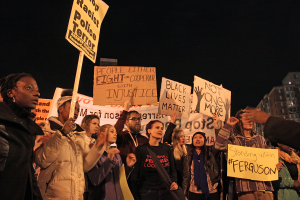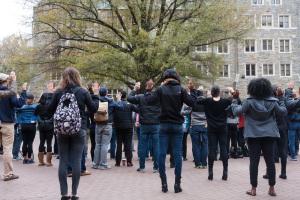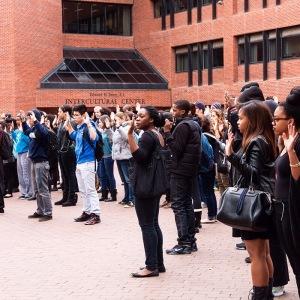
Protestors marched from Mount Vernon Square through Chinatown last night in response to the Ferguson verdict on Monday.
Protests erupted across the nation and around Washington, D.C., following St. Louis County Prosecuting Attorney Robert McCulloch’s announcement Monday night that Ferguson, Mo. police officer Darren Wilson would not be indicted in the fatal shooting of unarmed black teenager Michael Brown.
D.C. protesters dissatisfied with the decision rallied in front of the White House on Monday night and organized further demonstrations on Tuesday, including a silent protest on Georgetown’s campus. Students and professors at the university expressed discontent with the ruling, having held multiple reflections throughout the semester to discuss the unfolding events in Ferguson.
On Monday night, hundreds of D.C. protesters responded to the grand jury’s decision with a march from U Street to the White House. Among the protestors were numerous students from Georgetown, some of whom marched down Pennsylvania Avenue chanting, “Hands up, don’t shoot.”
“I’m a strong advocate for justice, and showing that all lives matter and black lives matter,” said Kattlyn Carpenter, a freshman at Howard University who attended the rally at the White House. “This isn’t just a hashtag or a moment. We’re really going to stand for it.”
Protesters began marching to the White House shortly after the 9:20 p.m. announcement of the decision, concurrent with President Barack Obama speaking on national television to urge protesters to remain peaceful. By 11 p.m., a large crowd had convened but remained peaceful.
For some protesters, the demonstration served as an emotional outlet following the grand jury’s widely awaited decision.
“I heard that a group of students was coming down here to convey a very deep sense of despair at the lack of an indictment of Darren Wilson,” Chris Wager (COL ’17) said. “I’m honestly just really pissed off and needed to channel that energy and needed to support the community.”

Students joined protests last night that started in Mount Vernon Square.
Around 500 demonstrators gathered outside the White House for over an hour, chanting slogans such as “Black lives matter” and singing hymns. The protesters left at midnight and marched through Chinatown, closing many roads and intersections.
“We want to make a point that black lives do matter and that it’s not OK to kill. Justice should be served for Mike Brown and for Trayvon Martin and for all the lives that were lost unjustly,” Howard freshman Ngodoo Iye said.
Protests in D.C. continued on Tuesday with demonstrations at the Metropolitan Police Department headquarters, the Office of Police Complaints, the D.C. Council and Mayor-elect Muriel Bowser’s transitional office.
At 7 p.m. on Tuesday, thousands of protesters convened at Mount Vernon Square for an even larger rally than the night before. The demonstrators marched through Chinatown and ended their protest at around 9:30 p.m. at the American Art Museum.
Protesters chanted slogans including “No justice, no peace” and “Don’t shoot” as they marched, and many carried signs condemning racism and police brutality. At several times during the march, protesters also yelled, “F—k the police,” in response to the MPD officers who were keeping watch on the rally.
“We just want to see black people get justice and be spoken up for. They deserve to have rights, and black lives do actually matter,” said Emonte Wimbush, a member of Black United Students at Kent State University, who participated in the march.
While many D.C. Ferguson protests incorporated mass chanting, a demonstration at Georgetown chose silence.
Dozens of students gathered in Red Square on Tuesday at 12:28 p.m. for a silent demonstration, which was organized by Georgetown’s Black Leadership Forum and lasted less than 10 minutes.

Students gathered for a silent demonstration in Red Square at 12:28 p.m. on Tuesday.
Demonstrators stood in silence with their hands raised for nearly five minutes. After the silent demonstration, some participants sang a brief song before the group disbanded.
In the weeks following Brown’s death on Aug. 9, both peaceful and violent protests broke out in the St. Louis suburb, eliciting increasingly aggressive police enforcement tactics. The mounting tensions quickly garnered national attention, and spotlighted race relations. Just days after Brown’s death, the Federal Bureau of Investigation opened a civil rights investigation of the shooting. The investigation is ongoing.
The university community addressed the conflict through several events. At the start of the semester, students led a vigil in Red Square on Aug. 26, while Provost Robert Groves and several university professors held a panel discussion in Gaston Hall on Aug. 28. The Black Leadership Forum and the Center for Social Justice also co-hosted a “Ferguson Teach-In” on Sept. 17, featuring roundtable discussions, panels and student presentations. Students from the Georgetown chapter of NAACP, Black Student Alliance, Program on Justice and Peace, Patrick Healy Fellowship, Georgetown Solidarity Committee and United Feminists traveled to Ferguson as part of the “Weekend of Resistance” in October, in a trip sponsored by the Center for Social Justice and the Office of Affirmative Action Programs.
GU NAACP President Mikaela Ferrill (COL ’15) voiced her disappointment in the grand jury’s decision and said that she thought it was indicative of an ongoing trend in America.
“I am sad, angry, and upset with the grand jury’s decision. Time and time again, America proves that it does not value the lives of black men and women,” she said.
Crystal Walker (SFS ’16), who travelled to Ferguson in October to participate in the “Weekend of Resistance” along with Ferrill and 15 other Georgetown students, said that she was not surprised by the decision.
“It’s a shame that our judicial system failed to address and confront such a pressing issue and problem in this so-called great country,” Walker said.
LaDarius Torrey (COL ’17), who also made the trip to Ferguson, said that he felt a mix of emotions upon hearing about the grand jury’s decision. Torrey said that while he is upset about the decision, he also fears for the future.
“I’m angry, actually beyond pissed, on one hand, and completely frightened and left hopeless on the other,” Torrey wrote in an email. “The case of Michael Brown is not an isolated incident, it’s a recurring theme in ‘our’ nation.”
Torrey co-produced a video called “Am I Next?” in September as a response to Brown’s death. The video, which depicted a group of young men standing on the steps of Healy Hall while Walter Kelly (COL ’16) delivered a spoken word poem, aimed to highlight misconceptions about young black men.

Students participating in the silent demonstration in Red Square on Tuesday.
“Many call this a race war, but how is this so? There is no level playing field or battleground,” Torrey wrote. “The system has been structured to work against us, and the police, who are supposed to be held accountable to protect us all, are the main perpetrators of injustice in America.”
Members of the Georgetown community voiced their reactions to the grand jury’s decision on social media. Sociology professor Michael Eric Dyson and history professor Marcia Chatelain took to Twitter to express their discontent.
“This is a profound miscarriage of justice and a slap in the face of all citizens who cherish democracy,” Dyson wrote. “We must continue to fight this injustice.”
Chatelain urged other professors to incorporate the events into their classes.
“And so we start again…consider teaching ‘The Making of Ferguson’ … tomorrow,” Chatelain tweeted, providing a link to a Dissent Magazine article with the same name and using the hashtag #FergusonSyllabus.
Ferrill said she is not discouraged by the jury’s decision, but rather will use it as motivation in what she said is a fight for social justice. She added that the Georgetown community should also take a closer look at diversity in education.
“I challenge the entire Georgetown community, students, faculty, and staff to take this as an opportunity to think critically about what happened in Ferguson and what happens in various communities everyday,” Ferrill said. “It is upsetting to see students not using their privilege to cause social change.”





















Kit Marlowe • Dec 1, 2014 at 11:38 am
https://www.youtube.com/watch?v=xpsQwl_19M4
Kit Marlowe • Nov 28, 2014 at 10:56 am
On Monday night, after the release of the grand jury verdict rejecting indictment of Officer Darren Wilson in the Ferguson, Missouri shooting of 18-year-old black man Michael Brown, President Obama took to the microphones. “We need to recognize that this is not just an issue for Ferguson, this is an issue for America,” he said. “[T]here are still problems and communities of color aren’t just making these problems up.”
Obama was wrong, at least in the case of Darren Wilson. In viewing thousands of pages of FBI interviews and grand jury testimony, it becomes eminently clear that many members of the local community did make up the story about Michael Brown being executed by Wilson – and pressured others to lie to police or keep silent.
According to the St. Louis County Police Investigative Report, the mob mentality took root almost immediately after the shooting. By the time detectives arrived at the scene of the incident, there was “a large crowd of bystanders and a large uniformed police presence at the scene when detectives arrived.” That crowd included both Brown’s mother and his stepfather, according to witness testimony. The police report states, “Many individuals were clearly upset and were expressing their frustration, by at times yelling obscenities and threats, and attempting to encroach on the crime scene itself.”
It got worse:
As the scene investigation continued, there were several large groups of hostile individuals around the perimeter of the crime scene. The investigation of the scene was interrupted several times by death threats directed toward police officers and gunshots being fired by an unknown persons around the crime scene.
According to the police report, a bevy of witnesses described intimidation from the local community, as well as falsification of testimony. One witness initially told police she didn’t want to “get involved for fear of retaliation.” She said, “I don’t know these people. I have to live here.”
Another female witness told police, “I don’t know nothin’.”
An adult male near the scene “commented to detectives as they walked by that he witnessed the incident and the officer was ‘in the right’ and ‘did what he had to do.’ He added the statements being made by bystanders in the complex were inaccurate. The detectives momentarily stopped to speak with the male who was clearly uncomfortable speaking with detectives. The male indicated he was not making any further comments or identifying himself.”
Two more witnesses, one male and one female, “said they were afraid to speak about what they witnessed. Both said they were worried about retaliation from people who live in the area.” One “began crying and said she could not talk about it.” The male said that he saw Brown inside the vehicle. He turned away, and when he turned back, “the male began moving quickly toward the officer and he heard several more gunshots.” Both witnesses refused to provide recorded statements.
One witness told police that “she had been speaking to her neighbors about the incident, and her neighbors were getting upset at what they believed happened. Their beliefs were inconsistent with what she witnessed.”
Yet the witness told police “that although present during the incident, and seeing the entirety of what happened, he would not be speaking to police for fear of retaliation from neighborhood residents. He also stated the information being broadcast by the news outlets was not accurate information and there were ‘blatant lies from those giving accounts of what they saw.’ He said there were multiple people present when the shooting occurred and even those people, when interviewed by the media, were giving false statements.”
Still another witness told police he had “already told investigators from Saint Louis County Police Department and the Federal Bureau of Investigation that he was not willing to formally discussed the incident, but he was willing to discuss his fears.” He said “threats… had been made to the residents of Canfield Green Apartment Complex. He said notes had been posted on various apartment buildings threatening people not to talk to the police, and gunshots were still being fired every night.” He said “there were at least 10 other people who were outside and saw exactly what happened. He was not willing to provide names of any of those individuals.” He said Wilson told Brown “no less than 10 times to get down” while they were both on the street. He said Brown never had hands raised.
In FBI interviews, witnesses repeated such accusations. Witness 10, whose account backed Wilson’s story, said, “I just wanted to come forward and just tell it how I seen it. Because I feel like it’s very rare that somebody’s gonna come forward and tell actually what happened.” Witness 14, who initially said Brown was shot from behind before changing his story to accord with the facts, stated:
You have to understand the mentality of some of these young guys they have nothing to do. When they can latch on the something they embellish it because they want something to do. This is something they giving the okay now we got something we can get into… The majority of them do not work. They all they do is sit around and get high all day… two people never seen these people before in my life in the whole time I have been out there and I sit out there a lot. Came up threatenin’, hey y’all better not say nothing, ah, you’ll snitching and all.
Witness 14 added that within one minute of the shooting, there were 70 or 80 people “saying things that didn’t happen,” and they “started embellishing it when the stepfather showed up.” They lied, he said, when they said the officer “ran up behind him shot him in the back.” They lied, he said, when they said he had “his hands straight up in the air.” They lied, he said, when they stated that Brown was shot while down. “They had it in they mindset of what happened,” he continued. “They are set they are looking for a reason to explode, that’s what they, ‘cause they don’t have anything to do… They got nothing else to do they running all day they’re drinking and-and getting high all day we see this all the time.”
And indeed, witness testimony showed that witnesses routinely embellished their accounts, changed them to fit autopsy results as those results broke in the media, and even lied about seeing the events at all.
After Dorian Johnson, Brown’s alleged accomplice in robbing a local convenience store, went on television and told his false story about Brown having been shot from behind and raising his hands before being killed, witnesses began shifting their own testimony to match. Multiple witnesses said they knew Johnson, and one said she had spoken with him before talking to the FBI. Two witnesses brought handwritten notes to police matching in wording and other respects.
At least 12 witnesses claimed that Brown was shot from behind, which was factually false. At least 16 witnesses said Brown’s hands were up when he was shot, which was factually false. One witness said Wilson used a Taser, then a gun: false. Another said she witnessed the events, but admitted she was blocks away when the events occurred. Still another witness said there were two officers involved in the shooting, and admitted she couldn’t tell what she’d seen and what she’d read about the case. One witness admitted in testimony to changing his story to “coincide with what really happened.” Another witness said that he was friends with Brown, and that Brown was shot while on his knees. When informed that such a story contradicted all physical evidence, the man admitted that he had not seen the shooting and then asked if he could leave because he was “uncomfortable.”
The looting and rioting and protesting are all secondary to the astroturfed case against Officer Darren Wilson in the first place. At least in Ferguson, one “community of color” did make this problem up. The media went along with it, ignoring the intimidation and the witness’ lying. And an innocent man, by all available physical evidence and a vast majority of the reliable witness testimony, could have gone to prison or death row because of it.
Kit Marlowe • Nov 26, 2014 at 9:42 am
“Demonstrators stood in silence with their hands raised.” Has it not yet filtered through to the campus that the forensic evidence and testimony of black eyewitnesses show that Mike Brown’s hands were not raised as he charged the policeman? Meantime, it is to GU students’ credit that their protest was silent.